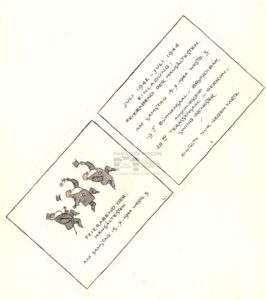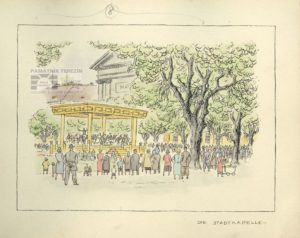Joseph Eduard Adolf Spier (1900 – 1978)
Jo Spier was a famous Dutch artist, author of humorous illustrations and caricatures depicting everyday life before the WWII. He worked for the De Telegraaf newspapers.
At the time when Jews were already persecuted in the Nazi-occupied Netherlands, the Spier’s family was helped through the acquaintance with Anton Mussert, head of the local National Socialist Movement and an admirer of Jo´s drawings at once. Jews were excluded of the party in 1938 and Mussert tried to take care of at least some of them. Among those was the family of Jo Spier, who himself had not been in the party though. Mussert failed to protect this group permanently. Its members were put on the list of the first transport from Westerbork to the Terezin ghetto.
In this way Jo Spier, his wife and their three children were deported to the Terezin ghetto by transport labelled XXIV/1 at the end of April 1943. In Terezin Jo became involved in the work of Werkstätte für Kunstgewerbe und Gebrauchsmalerei (arts and crafts workshop and utility painting). His name is associated with delicately coloured drawings depicting the Terezin ghetto as it was not in reality. His poetic image was also to be found in the header of any official communication of the Jewish administration. He also took part in the beautifying activity when he created the artwork for the commemorative album Bilder aus Theresienstadt (Terezin postcards), which was handed out as a souvenir to members of the delegations and other Nazi leaders. During a visit of ICRC delegates in June 1944, Spier was passed off as a representative of the Dutch Jews in the Terezin ghetto. A few months later, when shooting a propaganda film, he created, most likely following a command from the SS police station (as the Terezin SS Kommandantur was renamed at the time of beautification), the drawing documentation for the screenplay of this film.
Joseph Spier and his family lived in the ghetto to see the liberation. Afterwards they returned to the native Netherlands. Due to unproven accusations of collaboration the family emigrated to the United States in 1951.
Fate of Friedrich and Louisa Gutmanns
At the end of May 1943 two more people increased the ghetto population numbers; the Gutmann spouses. They arrived in Terezin from Bohusovice in a personal car loaded up with luggage, which produced a great response among the Terezin prisoners. They were a German-Jewish couple, citizens of the Netherlands. Additionally, they were assigned to the first Dutch transport (XXIV/I).

Invitation to an evening party hosted in honour of the “Hausälteste” (house captains), author: Jo Spier, PT 4235
Why did they receive so much attention though? The Gutmann family was well known in the banking world since Baron Friedrich Gutmann’s father was the founder of Dresdner Bank. The family also had ties to the high Italian nobility. Friedrich Gutmann’s sister was married to Baron Orsini, a former Italian ambassador in Berlin. Gutmann himself had friends among the prominent Italian personalities.
At the time when Jews began to be interned in the Westerbork camp in the Netherlands, the Gutmanns were receiving certain protection and privileges thanks to their relations with Italian diplomacy and their property. However, they did not succeed in obtaining a permission to leave the occupied country. The Italian relatives tried to exert influence in diplomatic circles. Italian ambassador in Berlin lobbied for them at Himmler. He allegedly promised, after an agreement with Mussolini, not to do any harm to the spouses. SS stations in Hague were reportedly given instructions to leave the Gutmanns in their apartment and exclude them from security police measures of general nature. Nevertheless, that did not guarantee them any protection against “special nature” measures (so-called Sonderbehandlung), i.e. against the despotism of other leading Nazis. In fact, power struggles appeared among them in such cases and many rescue operations were so caused to fail.
Reich Commissioner for the occupied Netherlands Seyss-Inquart did not want to let the Gutmanns leave the country until part of their property would be transferred to the Third Reich, namely a collection of German gold and silver objects from the 16th and 17 centuries set up by Gutmann’s father, as well as the paintings of old masters and impressionists: Göring was interested in those collections.
Later, after the second intervention, the Gutmanns were allowed to leave. They went to the border in a first class train car, there they changed for the second class and continued via Berlin to Bohusovice, where they got into a car, but instead of finding freedom, were taken to the ghetto.
Both spouses Louise and Friedrich were assigned work in Terezin. Friedrich Gutmann helped to distribute coal; Louise distributed bread and taught English. They were allowed to write to Rome and Florence. During their internment in the ghetto Friedrich Gutmann was summoned to headquarters, where he was put under pressure to sign a document and give up his property, which he refused. At that time also other negotiations were on regarding their departure or at least a permission to have visitors in Terezin.
Although the Nazis in the ghetto did not make the Gutmanns transfer their property to the German Reich, the couple was finally told that they had been allowed to leave for Italy. They were taken together with their luggage by car from the ghetto, but only to the police prison in the Small Fortress Terezin, where their detention continued. It was in mid-April 1944. Ghetto inmates were long convinced of the fact that the prominent couple had been set free. It was after a few months that some information about their detention in the Small Fortress trickled out into the ghetto.
Friedrich Gutmann died in the Small Fortress in April 1944. After his death, Louise lost any protection from deportation to the East. She was put on a transport to Auschwitz in August 1944, where she died in the gas chamber.
Se




